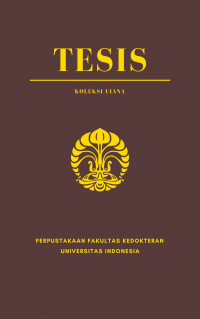Tesis
Prediksi Keberhasilan Terapi Latihan Otot Dasar Panggul Sebagai Terapi Inkontinensia Urin Tekanan = Prediction of Pelvic Floor Exercise as Stress Urinary Incontinence.
Latar Belakang: Inkontinensia urin tekanan (IUT) didapatkan pada 51% perempuan. Tatalaksana IUT dapat berupa terapi non operatif maupun operatif. Latihan otot dasar panggul (LODP) merupakan terapi non operatif IUT yang efektif, noninvasif, dan lebih cost effective; namun tingkat keberhasilan LODP bervariasi sehingga perlu dikaji faktor-faktor yang prediktif terhadap keberhasilan terapi LODP. Faktor-faktor tersebut adalah usia, jumlah kebocoran urin awal, kekuatan kontraksi otot dasar panggul awal, hipermobilitas uretra, dan kadar miostatin. Tujuan: Menyusun model prediktor keberhasilan LODP sbg terapi IUT berdasarkan usia, jumlah kebocoran urin awal, kekuatan kontraksi otot levator ani awal, hipermobilitas uretra, dan kadar miostatin. Metode: Desain penelitian nested case control , analisis regresi logistic. Hasil: Melibatkan 58 perempuan dengan IUT yang diterapi LODP sesuai buku panduan selama 12 minggu. Didapatkan 5 subjek drop out, 31 subjek mencapai keberhasilan terapi, dan 22 subjek tidak mencapai keberhasilan terapi. Dari analisis regresi logistic didapatkan faktor jumlah kebocoran urin awal dan pendidikan sebagai prediktor keberhasilan terapi. Kesimpulan: Keberhasilan terapi LODP pada IUT dapat diprediksi dengan jumlah kebocoran urin awal dan pendidikan.
Kata Kunci: Inkontinensia Urin Tekanan, Latihan Otot Dasar Panggul, Skor Prediksi, Keberhasilan Terapi
Background: Stress urinary incontinence (SUI) found in 51% women. Management of SUI could be done operatively or non operatively. Pelvic Floor Exercise (PFE) is an effective, noninvasive, and cost effective treatment for SUI. However, the success rate of PFE is vary, thus we need to evaluate factors predictors for PFE success. Those factors are age, amount of initial urinary leakge, pelvic floor muscle contraction strength, urethral hypermobility, and myostatin level. Objective: Developing prediction model of PFE success in SUI teraphy according to age, amount of initial urinary leakge, pelvic floor muscle contraction strength, urethral hypermobility, and myostatin level. Methods: Nested case control study, with logistic regression analysis. Results: Involving 58 women with SUI being treated by PFE according to guide book for 12 weeks. There were 5 subjects drop out, 31 subjects reached the treatment success, and 22 subjects not reached the treatment success. Logistic regression analysis found amount of initial urinary leakage and education as predicting factor for treatment success of PFE. Conclusion: Success of PFE as SUI treatment could be predicted by amount of initial urinary leakage and education.
Keywords: Stress urinary incontinence, pelvic floor exercise, prediction score, treatment success.
- Judul Seri
-
-
- Tahun Terbit
-
2021
- Pengarang
-
Gita Nurul Hidayah - Nama Orang
Joedo Prihartono - Nama Orang
Nurhadi Ibrahim - Nama Orang
Fernandi Moegni - Nama Orang
Surahman Hakim - Nama Orang - No. Panggil
-
T21352fk
- Penerbit
- Jakarta : Sp-2 Obstetri dan Ginekologi., 2021
- Deskripsi Fisik
-
xii, 153 hal; ill; 21 x 30 cm
- Bahasa
-
Indonesia
- ISBN/ISSN
-
-
- Klasifikasi
-
NONE
- Edisi
-
-
- Subjek
- Info Detail Spesifik
-
Tanpa Hardcopy
| T21352fk | T21352fk | Perpustakaan FKUI | Tersedia |


Masuk ke area anggota untuk memberikan review tentang koleksi